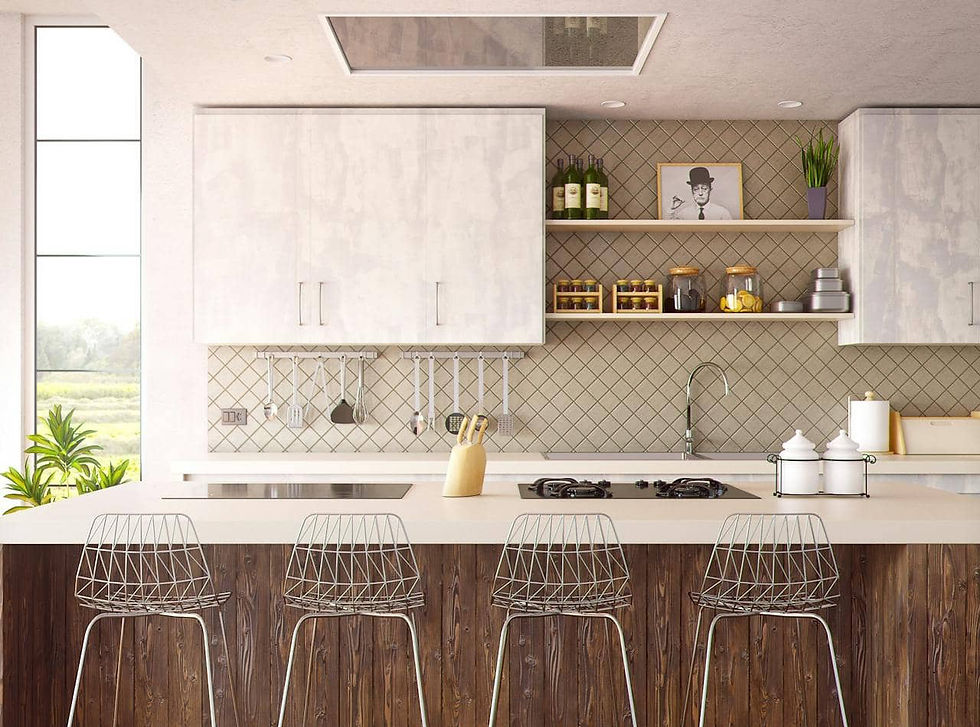Your Dishes Aren't The Only Thing Making Your Kitchen A Mess
- Imagine It Done
- Aug 12
- 3 min read

The kitchen is the heart of the home, serving as a command center where family members gather, cook, eat, and connect. But because it’s such a high-traffic area, it can quickly become a cluttered mess. While dirty dishes are an obvious culprit, they’re not the only things making your kitchen look chaotic. Everyday items like mail, groceries, small appliances, and even kids' toys can pile up, turning your kitchen into a disaster zone.
The good news? Kitchen clutter can be tamed with simple routines and strategic organization.
Here’s how to identify what’s making your kitchen messy and how to fix it.
Why Does Kitchen Clutter Build Up?
Clutter happens for two main reasons: poor routines and a lack of designated storage spaces. Without a system in place, kitchen counters, cabinets, and even floors become dumping grounds for random items. The key to keeping your kitchen organized is developing habits that prioritize tidiness and assigning a proper home for everything.
Think of kitchen clean-up like your bedtime routine—just as you brush your teeth before bed, you should make it a habit to clear countertops and put everything back where it belongs every night. Eliminating unnecessary allows the necessary to speak.
Follow The Imagine It Done 5-Step Process
To keep your kitchen organized, follow this simple five-step process:
Edit – Remove unnecessary items from your kitchen.
Categorize – Group similar items together for better organization.
Contain – Use bins, baskets, and storage solutions to keep things in place.
Curate – Be intentional about what stays on display and what gets stored away.
Personalize – Arrange your kitchen to fit your daily needs and lifestyle, update new labels as needed.
Common Clutter Culprits & How to Store Them Properly
Here are the most common items causing kitchen clutter and better ways to store them:
Cookbooks & Recipe Books
Store them inside a kitchen island or pantry shelves instead of keeping them on the countertop.
Mail, Keys, Loose Change & Miscellaneous Items
Set up a compartmentalized junk drawer for small items.
Use bins in an entryway console table for larger items like backpacks and shopping bags.
Dirty Dishes
Place them in the dishwasher immediately instead of leaving piles in the sink.
Groceries & Shopping Bags
Put away groceries as soon as they hit the counter.
Store reusable shopping bags neatly instead of letting them pile up.
Expired & Unused Food
Regularly check and toss expired condiments, spices, and leftovers.
Store food in airtight glass containers to keep the fridge organized.
Homework & Backpacks
Assign a designated after-school station in the dining room or kids' bedrooms.
Toys
Keep them in the playroom or children’s bedrooms rather than scattering them around the kitchen.
Hairbrushes & Cosmetics
Store these items in bathroom drawers, not the kitchen.
Small Appliances
Keep frequently used appliances on accessible countertops.
Store less-used appliances in lower cabinets or the pantry.
Fridge Art & Paper Clutter
Store kids’ artwork in a scrapbook or rotate display pieces regularly to keep the fridge door clutter-free.
Old Pots & Pans
Regularly inspect for deep scratches or grime that can’t be cleaned—then toss and replace.
Dirty or Tattered Floor Mats
Clean mats regularly or replace them if they’re beyond repair.
Unnecessary Items You Should Toss Immediately
Some things simply don’t belong in your kitchen and can be removed altogether:
Junk mail
Excess cookbooks
Kids’ toys
Shopping bags
Unused gadgets (e.g., extra cords, broken tools)
Worn-out floor rugs
The Most Cluttered Kitchen Spaces & How to Fix Them
Countertops
The most common clutter zone—keep them clear by cleaning up daily.
Follow the "one in, one out" rule: Only bring in a new item when you remove an unnecessary or expired one.
Set a 5-10 minute timer daily to tidy up. You’ll be surprised how much you can accomplish!
Cabinets & Fridge
Check them weekly to take inventory and prevent over-purchasing.
Keep only what you use and toss expired or unused items.
Pantry
Organize food by category in clear containers to make everything easy to find.
Remember, your kitchen countertops should be a workspace, not a storage space. By following these organization tips and routines, you can keep your kitchen clutter-free and functional, making it a more enjoyable space for cooking, gathering, and connecting with family and friends.



